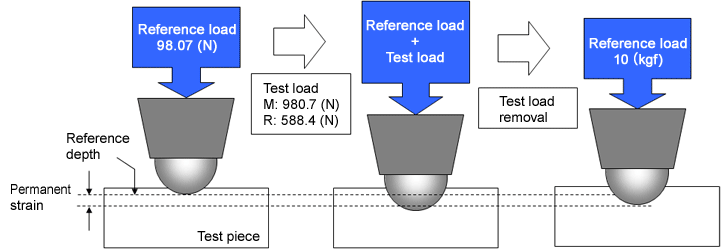- HOME
- Technical Information
- TORELINA™ PPS Resin
- Various Properties
- Mechanical Properties
- Surface Hardness
Surface Hardness
Ⅰ. Notes on Surface Hardness
Surface hardness is largely divided into three types, indentation hardness (including Vickers hardness, Brinell hardness, and durometer hardness), scratch hardness (including Mohs hardness and Martens' hardness), and rebound hardness (including Shore hardness), each of which is used appropriately according to the object. For the surface hardness measurement of a plastic, Rockwell hardness (indentation hardness) is often used, as the measurement can be done both simply and quickly.
Ⅱ. Rockwell Hardness
Indenters for use in Rockwell hardness measurement are available in two types, diamond cone and steel sphere. These types are classified according to the load applied and the curvature. For the measurement of the Rockwell hardness of TORELINA™, the M scale (1/4-in steel sphere, 6.35 mm diameter) and the R scale (1/2-in steel sphere, 12.7 mm diameter) are used. This method uses indenters with a steel sphere at the tip. For Rockwell hardness measurement, the permanent strain (h) is measured with an indenter in contact with the molded product surface by following the steps in this order: (1) application of the reference load (reference depth), (2) application of the test load for 15 seconds, and (3) dent depth measurement 15 seconds after the removal of the test load. (Fig. 5.83) For plastic, which is a viscoelastic body, compression creep occurs when the test load is applied, so that the dent depth changes with time. Thus, JIS and other standards specify a load time. Rockwell hardness can be determined from the dent depth thus obtained, in accordance with Formula 5.3. If the permanent strain (h) is zero, the Rockwell hardness is 130, which is the maximum possible value.

Fig. 5.83 Rockwell hardness measurement method (contact portion)

The Rockwell hardness of TORELINA™ is given in Table. 5.11. The Rockwell hardness of reinforced PPS depends on the reinforcement content and whether it is improved with elastomers. With the R scale, unreinforced PPS exhibits a surface hardness equivalent to that of reinforced PPS, whereas with the M scale, it exhibits a lower surface roughness. As described in Section 5.1.2, unreinforced PPS has a wider elastic region than reinforced PPS, so that with indentation with low load, the deformation amount does not reach the plastic region. It is, therefore, assumed that the apparent surface hardness is high because of the elastic recovery after unloading.
Thus, the surface hardness of a plastic, which is a viscoelastic body, has a different tendency depending on the shape of the indenter and the load. It is thus important to select the appropriate measurement method and conditions according to the purpose.
Table. 5.11 Rockwell hardness of TORELINA™ (23℃)
| Item | Glass fiber reinforced | Glass + filler reinforced | Elastomer improvement | Unreinforced | ||||||
|---|---|---|---|---|---|---|---|---|---|---|
| A504X90 | A604 | A310MX04 | A610MX03 | A673M | A575W20 | A495MA2B | A900 | A670T05 | ||
| Rockwell hardness |
R scale | 122 | 122 | 123 | 123 | 114 | 117 | 115 | 122 | 116 |
| M scale | 98 | 98 | 100 | 100 | 85 | 88 | 85 | 84 | 68 | |